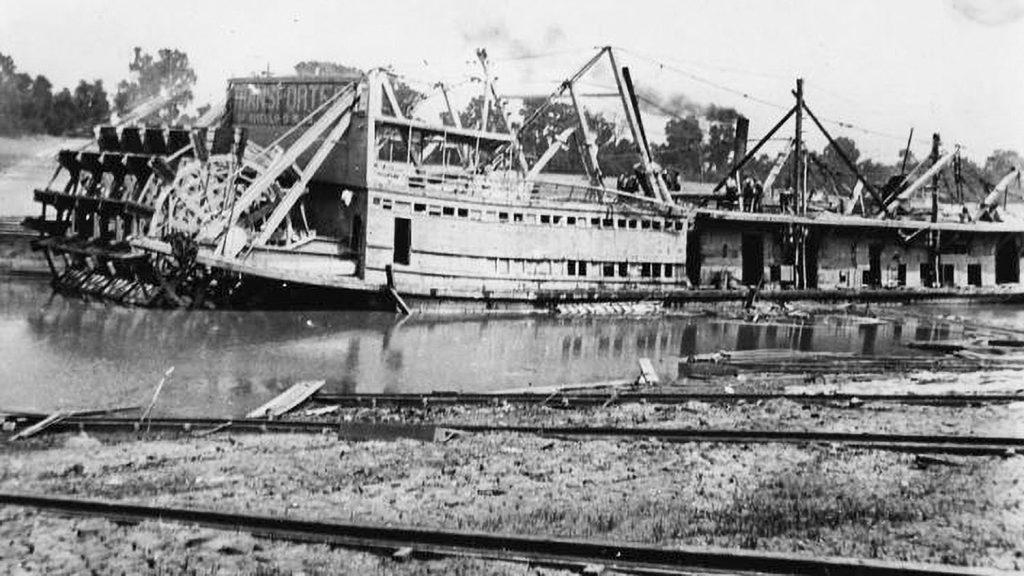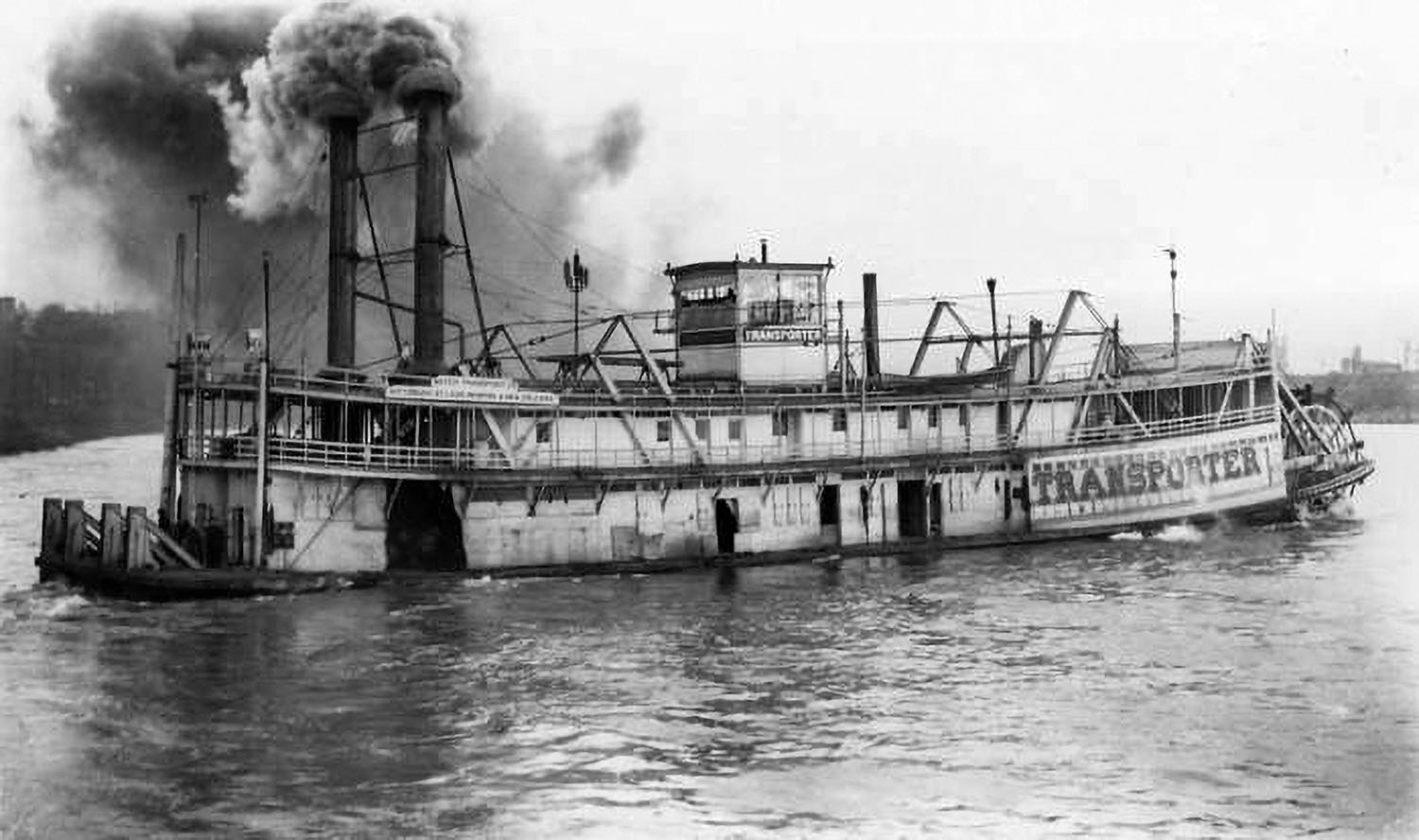In January 1921, the Water Transport Company, Pittsburgh, of which Capt. Charles T. Campbell was head, purchased the Combine (Monongahela River Consolidated Coal & Coke Company) towboat Valiant and had it rebuilt at Elizabeth, Pa.
The Valiant was originally the Jos. Nixon, which was built at Pittsburgh in 1877. This boat was sternwheel, with a wood hull 163.5 by 26 feet. The engines were second-hand, having been on the Hercules, which was built in 1864. In Way’s Steam Towboat Directory, the Hercules is shown with engines that are 18’s – 7-foot stroke, but the Jos. Nixon, though listed as having engines from the Hercules, is listed with engines that are 20’s – 7-foot stroke. The horsepower was estimated at 500.
The Nixon was rebuilt in 1894 and renamed Valiant. The hull width had increased to 28.6 feet after this. In 1900, the boat went into the Combine. Capt. Fred Way mentions in his Steam Towboat Directory that Capt. William F. Brookhart was master of the boat “for a long while.” Way later worked with Brookhart on the packet General Crowder. During this time, he says Brookhart often mentioned the Valiant and considered it the best of the old coal boats.
With the demise of the Combine and the cessation of large tows of coal going from Pittsburgh to New Orleans, many of the big steam sternwheel towboats were laid up. In 1916, the Valiant was relegated to the “boneyard,” as the fleets of laid-up steamers were termed, to await a fate that usually became scrapping.
Water Transport Company saved the Valiant from the breakers. It was rebuilt at the Elizabeth Marine Ways and renamed Transporter. The hull width was now recorded as being 33.5 feet. Following the rebuild, Capt. William S. Pollock took several photos of the boat on a trial run to just above the Emsworth Locks, where it turned back to Pittsburgh. Though the boat had just been redone, the photos show it looking a bit dingy.
After entering service, the Transporter is credited with taking the first full tow of steel products down the Ohio River. Water Transport did not stay in business long, and the Transporter was sold in September 1922 to La Belle Transportation Company, a part of Wheeling Steel & Iron Company that later became Wheeling Steel Corporation.
Under Wheeling Steel, ownership photos show the boat in pristine condition. Way’s says that the boat towed steel products from the Wheeling area to points south, and that Capt. George A. Foreman was master, with pilots being Capt. Pete Briscoe and Capt. Graham Varble.
On May 9, 1927, the Transporter was caught in a severe storm or tornado near Joppa, Ill., on the lower Ohio River. The boat was blown across to the Kentucky side and capsized. It was raised and taken to the Ayer & Lord Marine Ways at Paducah. Most of the cabin had been destroyed, but it was completely rebuilt looking much as it had originally, with the exception that the upper cabin now had no skylight.

The Transporter was idled through much of the Depression years and was eventually sold to Capt. Birch McBride of Louisville. The St. Louis news column of the March 27, 1937, issue of The Waterways Journal reported that the boat had arrived in the local harbor from Baton Rouge with “a dredge and a barge for Siems-Helmers Inc. and six other pieces to be loaded here with coal for the Dewey Portland Cement Company’s plant at Davenport.” Capt. McBride was aboard and had told Andy Franz, author of the column, that the boat would be towing to Davenport regularly, making about one round trip from St. Louis weekly.
Low water made this work impractical, and the Transporter then towed for a while between St. Louis and Joliet. This eventually proved not to be profitable. In the December 3, 1938, issue of the WJ, C.W. Stoll wrote in the Louisville News column that the boat had been in the drydock in the Louisville and Portland Canal “for a few weeks,” and it had returned to the McBride landing at Harrod’s Creek and was “now ready for work.”
However, the Transporter would never work again. The boat was attached for debt, and a U.S. Marshal sale was scheduled. The December 17, 1938, WJ carried a feature story on page seven that stated the boat had caught fire and burned on December 12 while being towed to Louisville for the auction. It was being towed by the J.R. Nugent, and the crew of that boat noticed the smoke and fire when nearing Six Mile Island. The Transporter was cut loose and shoved ashore on the island, where it burned to the water’s edge. There had been no steam up on the Transporter, and it was reported that there had been no fire under the boilers.
Subsequent issues of the WJ had much mention of the Transporter. In the December 24 issue Frank L. Sibley, writing the “Gallipolis Gossip” column, lamented the end of the boat and detailed the feats of it and other large boats in the “palmy days of coal towing.” It was mentioned in the “Annual Holiday Issue” (now known as the Annual Review and Directory) of December 31, 1938, with J. Mack Gamble in his Annual Review column with a headline stating the burning of the boat was the “End of an Era.” He went on to say that the Transporter “was considered to be the last tracing direct descent from the famous fleet of boats which formerly pushed huge coal tows to southern markets.” Before speaking of the end of the Transporter, Gamble had highlighted a new era, mentioning the “modern trend” in towboat construction, citing the “streamlined, air-conditioned” J.H. Duffy, just completed by St. Louis Ship for the Ohio River Sand Company, Louisville with 900 hp. from two Busch-Sulzer diesels.
The Transporter had been a favorite of Capt. Birch McBride, and that is most likely the reason that there is today a 2,400 hp. diesel towboat in the fleet of McBride Towing Company, Harrods Creek, Ky., named Transporter.




